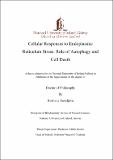| dc.description.abstract | This PhD thesis describes cellular responses to the induction of endoplasmic reticulum (ER) stress, focusing on the role of autophagy and cell death. Pro-survival role of unfolded protein response (UPR) is analysed by looking at the regulation of SESN2, protein responsible for the activation of pro-survival autophagy during ER stress. I show that two distinct arms of the UPR, IRE1 and PERK, can be involved in upregulation of SESN2. Next, the role of autophagy in the induction of cell death is examined, applying cellular models deficient in mitochondrial cell death pathway, a primary mode of cell death upon unresolved UPR. Our data shows that autophagy turns into a toxic mechanism in the absence of functional apoptotic machinery, and facilitates assembly of a novel cell death inducing complex. CASP8, a component of this complex, serves as an initiator caspase in the apoptotic cascade, providing efficient elimination of the affected cells. Finally, in this work I explore the possibility of ER stress to induce caspase-independent mode of cell death ¿ necroptosis. Necroptosis has not been previously associated with unresolved UPR. We discovered that ER stress-induced necroptosis depends on RIPK1, RIPK3 and TNFRSF1A. Intriguingly, TNFRSF1A was involved independently of either of its ligands, TNF or LTA. Therefore I provided a new role for TNFRSF1A in modulating ER stress-induced cell death. Finally, we conclude that necroptosis during induction of ER stress is executed by the same mechanism as upon TNF stimulation ¿ through MLKL-mediated plasma membrane permeabilization. This thesis provides a comprehensive overview on both pro-survival and pro-death mechanisms upon induction of ER stress, highlighting the importance of precise evaluation of different cellular systems in order to completely understand the mechanism behind the this type of stress response. | en_US |


